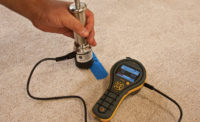Albeit labor-intensive, the “HEPA sandwich” method of traditional mold removal is still one of the most popular methods in the industry. Specifically, this practice occurs following the setup of containment barriers and after the removal and demolition of unsalvageable items and structures. It consists of using a high-efficiency particulate air (HEPA) vacuum to clean semi-porous and non-porous items, then damp wiping or wet cleaning the items, and then implementing another round of HEPA vacuuming to remove any leftover contaminants.
For an even more thorough cleaning, many mold remediation professionals repeat the HEPA sandwich process two to three times.
While the HEPA sandwich method is most popular on non-porous items, the process is also suitable on semi-porous items – such as upholstery and carpeting – as well. The difference in this case is that instead of damp wiping or wet cleaning items, affected items are cleaned with hot water extraction.
The HEPA sandwich method is effective for contaminant hazards that include mold and bacteria.





Report Abusive Comment